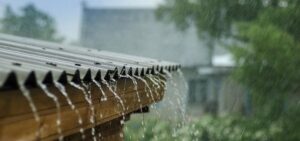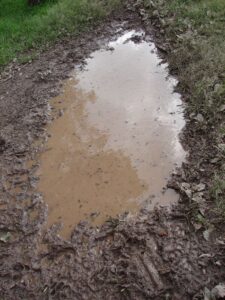Water collection, storage, and purification might easily take first place in improving overall living conditions. Clean water not only quenches the thirst, but also raises the food. Even in Uganda, where 40 – 60 inches of rainfall soak the land each year, there are dry seasons that can empty the natural wells and leave the people, livestock, and lands parched.
 How much rain? An inch falling on an acre of land is 27,152 gallons. That is a lot of water. If you collect an inch of water just from 800 square feet of a house’s rooftop, that provides 500 gallons. 500 gallons will barely take a family through a month of extra dry conditions, but remember: that’s just one inch of rain! If you are convinced, and ready to start collecting rain, click here for basic instructions on Building Rainwater Collection Systems. However, to understand the full theory and avoid problems, there is more to think about first!
How much rain? An inch falling on an acre of land is 27,152 gallons. That is a lot of water. If you collect an inch of water just from 800 square feet of a house’s rooftop, that provides 500 gallons. 500 gallons will barely take a family through a month of extra dry conditions, but remember: that’s just one inch of rain! If you are convinced, and ready to start collecting rain, click here for basic instructions on Building Rainwater Collection Systems. However, to understand the full theory and avoid problems, there is more to think about first!
Benefits
There are clear benefits to collecting rainwater, and some that are not so obvious. You will have water to drink! And you will also reduce the strain on community wells. Your surplus will water the garden, directly ! It will also stabilize and slow the feed of the water into the water table. That stability, in turn, keeps organic matter in the soil moist so that it holds more right away when the rains return. It also helps to limit the flooding. When it rains too hard, the ground cannot take the full supply, so the water stands on top of the soil and runs off to the lowest ground. Collecting some of it will minimize that final flooding. It also allows you to direct the overflow to better areas, so your house, garden, and animals do not get the worst of the flooding. A great benefit is being able to heat the water with the sun, too! Maybe the biggest benefit is that you have water right outside your door. No long walks with buckets to collect water from the community well!
Environmental Benefits
 Water collection benefits the entire community and its environment. As mentioned above, slowing the amount of water going into the ground will keep the soil moist while preventing erosion and flooding. This is very good for the garden, of course, but if the ground gets fully dry, it takes a lot of rain to get it wet again. After a long dry spell, the rain just runs right through the powdery soil. It takes some amount of standing water to get the ground wet again.
Water collection benefits the entire community and its environment. As mentioned above, slowing the amount of water going into the ground will keep the soil moist while preventing erosion and flooding. This is very good for the garden, of course, but if the ground gets fully dry, it takes a lot of rain to get it wet again. After a long dry spell, the rain just runs right through the powdery soil. It takes some amount of standing water to get the ground wet again.
Very dry ground also lets the good bacteria and fungus go dormant. Bacteria and fungus are the tiniest living things in your soil, and they feed water and nutrients to your plants. Once they go dormant, they have trouble “waking up” to do their job! When the bacteria go to sleep, the worms and good bugs leave, too. Bacteria and fungus are the good guys who turn the leftovers from your last crop back into food for little animals and insects who enrich it and spread it around for the new plants.
When you collect rain water, it does no harm to the environment at all. The water still goes into the ground, to the streams, lakes, and finally the ocean. It just stays with you briefly to provide you and your own environment a special drink.
Cautions
 Rainwater is clean and good, but it can quickly become contaminated. If you collect water, there are a few necessary precautions. First, if you gather roof water for drinking, you do not want the first flow. Over the dry period, dust, bird droppings, bug larvae, leaves, chemicals, ash, and other contaminants build up. You will want to let the first water wash away that dirt before collecting what follows. Second, you will need to filter the rainwater, both as it enters the barrel and again before you use it as drinking water. Of course, you not need to filter water for the garden. (Filtration is not difficult. We will discuss that later.) Third, standing water will quickly attract mosquitoes and other bugs that will lay larva in the water. Keeping the water free of bugs is important. After collection, barrels should be treated with bleach and closed, or kept in a pond or large container with fish. Fish enjoy eating the bugs and their larvae!
Rainwater is clean and good, but it can quickly become contaminated. If you collect water, there are a few necessary precautions. First, if you gather roof water for drinking, you do not want the first flow. Over the dry period, dust, bird droppings, bug larvae, leaves, chemicals, ash, and other contaminants build up. You will want to let the first water wash away that dirt before collecting what follows. Second, you will need to filter the rainwater, both as it enters the barrel and again before you use it as drinking water. Of course, you not need to filter water for the garden. (Filtration is not difficult. We will discuss that later.) Third, standing water will quickly attract mosquitoes and other bugs that will lay larva in the water. Keeping the water free of bugs is important. After collection, barrels should be treated with bleach and closed, or kept in a pond or large container with fish. Fish enjoy eating the bugs and their larvae!
Final Thoughts
Two separate collection systems provide the easiest and most efficient way to store water. A clean system for drinking, and a direct collection to use for washing and for the garden. This also allows more options. To plan how large your systems need to be, you will require two liters of drinking water per person per day. For a family of four, that is eight liters, or just about two gallons. It is not difficult to catch and keep two months of water for drinking. For a garden, you will need at least 30 liters (eight gallons) per month for each square meter of garden.
In addition, you will need to double your collection! You will lose water to evaporation, contamination, and other losses. For a household of four people, in other words, you need a minimum of four gallons of drinking water stored in advance for every day of the dry season. If you plan for three months, that means 4 gallons X 60 days, or 240 gallons (900 liters.) That will keep you healthy. 1,000 liters or more would be better! But remember, that’s just two inches of rain from your roof!
By now you should have a fair idea how much water you will want to collect. Next, we will look at Building Rainwater Collection Systems.
